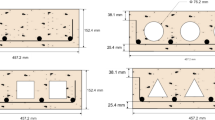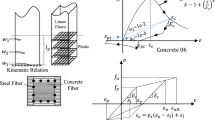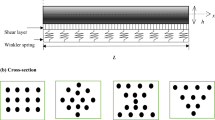Abstract
Topology optimization as a computational approach is used to find an optimal structure with specific objectives such as an ultimately lightweight design. The optimization is normally performed under a series of constraint functions to ensure expected structural performance for safety and resilience. To promote the use of topology optimization in structural engineering, it is crucially important to identify and apply suitable constraints for realistic construction. In this paper, a conceptual attempt aiming for a construction-oriented topology optimization framework is presented. An isogeometric analysis module using NURBS curves for geometric description and discretization is employed in stress analyses, which incorporates the density-based SIMP optimization approach to generate the optimized topology. A Drucker–Prager criterion is adopted to constrain the stresses within the unequal limits of tension and compression for the use of concrete type material. To prevent slim components of potentially high complexity in construction, a minimum-width control is applied as an additional geometric control. In this paper, the conceptual framework is demonstrated using a prestressed concrete beam, while the optimization is performed to find suitable density distribution of concrete and a NURBS-described tendon profile after imposing the mapped prestressed action. The iterative optimization processes are presented and demonstrated to investigate the effect of tensile-compressive strength ratio and the minimum width, which reflects the construction-oriented vision pursuing a more regularized topology after applying the constraints in optimization.
















Similar content being viewed by others
References
Almeida VS, Simonetti HL, Neto LO (2013) Comparative analysis of strut-and-tie models using smooth evolutionary structural optimization. Eng Struct 56:1665–1675
Amir O (2013) A topology optimization procedure for reinforced concrete structures. Comput Struct 114:46–58
Amir O, Sigmund O (2013) Reinforcement layout design for concrete structures based on continuum damage and truss topology optimization. Struct Multidisc Optim 47:157–174
Amir O, Shakour E (2018) Simultaneous shape and topology optimization of prestressed concrete beams. Struct Multidisc Optim 57:1831–1843. https://doi.org/10.1007/s00158-017-1855-5
Beghini LL, Beghini A, Baker WF, Paulino GH (2015) Integrated discrete/continuum topology optimization framework for stiffness or global stability of high-rise buildings. J Struct Eng 141:04014207
Bogomolny M, Amir O (2012) Conceptual design of reinforced concrete structures using topology optimization with elastoplastic material modeling. Int J Numer Meth Eng 90:1578–1597
Bruggi M (2009) Generating strut-and-tie patterns for reinforced concrete structures using topology optimization. Comput Struct 87:1483–1495
Bruggi M (2010) On the automatic generation of strut and tie patterns under multiple load cases with application to the aseismic design of concrete structures. Adv Struct Eng 13:1167–1181
Bruggi M (2016) A numerical method to generate optimal load paths in plain and reinforced concrete structures. Comput Struct 170:26–36
Bruggi M, Duysinx P (2012) Topology optimization for minimum weight with compliance and stress constraints. Struct Multidisc Optim 46:369–384
Bruggi M, Taliercio A (2013) Topology optimization of the fiber-reinforcement retrofitting existing structures. Int J Solids Struct 50:121–136
Cheng GD, Guo X (1997) ε-relaxed approach in structural topology optimization. Struct Optim 13:258–266. https://doi.org/10.1007/BF01197454
Costa G, Montemurro M, Pailhès J (2019) Minimum length scale control in a NURBS-based SIMP method. Comput Methods Appl Mech Eng 354:963–989
Deaton JD, Grandhi RV (2014) A survey of structural and multidisciplinary continuum topology optimization: post 2000. Struct Multidisc Optim 49:1–38. https://doi.org/10.1007/s00158-013-0956-z
Duysinx P, Sigmund O (1998) New developments in handling stress constraints in optimal material distribution. In: Proceedings of the 7th AIAA/USAF/NASA/ISSMO Symposium on Multidisciplinary Analysis and Optimization
Eschenauer HA, Olhoff N (2001) Topology optimization of continuum structures: a review. Appl Mech Rev 54:331–390
Eurviriyanukul S, Askes H (2011) Tendon layout optimisation through configurational forces equilibration in plane stress analysis of prestressed concrete structures. Comput Struct 89:1673–1680
Gao J, Gao L, Luo Z, Li P (2019) Isogeometric topology optimization for continuum structures using density distribution function. Int J Numer Meth Eng 119:991–1017
Gaynor AT, Guest JK, Moen CD (2013) Reinforced concrete force visualization and design using bilinear truss-continuum topology optimization. J Struct Eng 139:607–618
Hughes TJ, Cottrell JA, Bazilevs Y (2005) Isogeometric analysis: CAD, finite elements, NURBS, exact geometry and mesh refinement. Comput Methods Appl Mech Eng 194:4135–4195
Jewett JL, Carstensen JV (2019) Topology-optimized design, construction and experimental evaluation of concrete beams. Autom Constr 102:59–67
Jiang L, Usmani A (2018a) Computational performance of beam-column elements in modelling structural members subjected to localised fire. Eng Struct 156:490–502
Jiang L, Usmani A (2018b) Towards scenario fires–modelling structural response to fire using an integrated computational tool. Adv Struct Eng 21:2056–2067
Jiang L, Jiang Y, Zhang Z, Usmani A (2021) Thermal analysis infrastructure in OpenSees for fire and its smart application interface towards natural fire modelling. Fire Technol. https://doi.org/10.1007/s10694-020-01071-0
Kwak H-G, Noh S-H (2006) Determination of strut-and-tie models using evolutionary structural optimization. Eng Struct 28:1440–1449
Lazarov BS, Wang F, Sigmund O (2016) Length scale and manufacturability in density-based topology optimization. Arch Appl Mech 86:189–218. https://doi.org/10.1007/s00419-015-1106-4
Liang QQ, Xie YM, Steven GP (2000) Topology optimization of strut-and-tie models in reinforced concrete structures using an evolutionary procedure., American Concrete Institute
Lin TY, Burns NH (1981) Design of prestressed concrete structures
Liu H, Yang D, Hao P, Zhu X (2018) Isogeometric analysis based topology optimization design with global stress constraint. Comput Methods Appl Mech Eng 342:625–652
Luo Y, Kang Z (2013) Layout design of reinforced concrete structures using two-material topology optimization with Drucker–Prager yield constraints. Struct Multidisc Optim 47:95–110. https://doi.org/10.1007/s00158-012-0809-1
Moorman RB (1952) Equivalent load method for analyzing prestressed concrete structures. University of Missouri
Piegl L, Tiller W (2012) The NURBS book. Springer, New York
Rozvany GIN (2009) A critical review of established methods of structural topology optimization. Struct Multidisc Optim 37:217–237. https://doi.org/10.1007/s00158-007-0217-0
Sigmund O, Maute K (2013) Topology optimization approaches. Struct Multidisc Optim 48:1031–1055. https://doi.org/10.1007/s00158-013-0978-6
SIMOGroup (2016) SIMO-Package, a basic NURBS-based IsoGeometric Analysis package written in MATLAB. https://github.com/SIMOGroup/SIMO-Package
Stromberg LL, Beghini A, Baker WF, Paulino GH (2011) Application of layout and topology optimization using pattern gradation for the conceptual design of buildings. Struct Multidisc Optim 43:165–180
Stromberg LL, Beghini A, Baker WF, Paulino GH (2012) Topology optimization for braced frames: combining continuum and beam/column elements. Eng Struct 37:106–124
Svanberg K (1987) The method of moving asymptotes—a new method for structural optimization. Int J Numer Meth Eng 24:359–373. https://doi.org/10.1002/nme.1620240207
Vantyghem G, De Corte W, Shakour E, Amir O (2020) 3D printing of a post-tensioned concrete girder designed by topology optimization. Autom Construct 112:103084
Verbart A, Langelaar M, Keulen FV (2017) A unified aggregation and relaxation approach for stress-constrained topology optimization. Struct Multidisc Optim 55:663–679
Yang RJ, Chen CJ (1996) Stress-based topology optimization. Struct Multidisc Optim 12:98–105
Yang D, Liu H, Zhang W, Li S (2018) Stress-constrained topology optimization based on maximum stress measures. Comput Struct 198:23–39
Acknowledgements
The first author would like to acknowledge the financial support of the RISUD Ph.D. studentship and the corresponding author would like to acknowledge the support from the Start-up Funding of the Hong Kong Polytechnic University (P0031564).
Author information
Authors and Affiliations
Corresponding author
Ethics declarations
Conflict of interest
The authors declare that no conflict of interest is encountered in this paper.
Replication of results
MATLAB codes for the simply supported prestressed concrete beam optimized with 23 mm width control and 3:1 strength limit ratio is provided as supplementary materials to the journal. To ease the concern of program convergence, the effect of specific parameters are introduced here: (1) the step-up of penalty p accelerates the formation of optimized topology; (2) too high βHS do affect the convergence stability, a reasonable range is recommended (Amir and Shakour 2018); (3) the width of full-cover tendon filter βfil is irrelevant to convergence problem; (4) the range of tendon-concrete filter sharpness µpre is also recommended (Amir and Shakour 2018); (5) the epsilon-relaxation coefficient ε is a recommended value (Cheng and Guo 1997); (6) the value aggregation coefficient η and STM-based stress correction scheme qn are both recommended (Yang et al. 2018). The parameters used in this paper are determined according to these recommendations and similar process can be applied to other case studies.
Additional information
Responsible Editor: Matthew Gilbert
Publisher's Note
Springer Nature remains neutral with regard to jurisdictional claims in published maps and institutional affiliations.
Appendices
Appendix 1: The curvature sensitivity analysis of the tendon curve
The formulation of curvature can be written as:
where \({\mathbf{C}}^{\prime}\left( \xi \right),{\mathbf{C}}^{\prime\prime}\left( \xi \right)\) are the first and second derivative values of the tendon curve, respectively. For the sake of formulation simplicity, we define terms \({\mathbf{A}} = {\mathbf{C}}^{^{\prime}} \left( \xi \right) \times {\mathbf{C}}^{^{\prime\prime}} \left( \xi \right)\) and \({\mathbf{B}} = {\mathbf{C}}^{^{\prime}} \left( \xi \right)\). Therefore, the expression of Eq. (40) could be rewritten as:
where the term \({{\partial {\mathbf{A}}}}/{{\partial y_{i} }}\) is resulted in \(({{\partial {\mathbf{A}}}}/{{\partial y_{i} }}) = ({{\partial {\mathbf{C}}^{^{\prime}} \left( \xi \right)}}/{{\partial y_{i} }}) \times {\mathbf{C}}^{^{\prime\prime}} \left( \xi \right) + {\mathbf{C}}^{^{\prime}} \left( \xi \right) \times ({{\partial {\mathbf{C}}^{^{\prime\prime}} \left( \xi \right)}}/{{\partial y_{i} }})\); and the term \({{\partial {\mathbf{B}}}}/{{\partial y_{i} }}\) is straightforward: \(({{\partial {\mathbf{B}}}}/{{\partial y_{i} }}) = ({{\partial {\mathbf{C}}^{^{\prime}} \left( \xi \right)}}/{{\partial y_{i} }})\).
According to the formulation of the first and second derivative values of the tendon curve, the corresponding derivatives are given as follows:
Appendix 2: Normal direction sensitivity analysis of the tendon curve
The formulation of normal direction can be written as:
where \(\theta_{\xi }\) represents the angle at the location \(\xi\), and the expression could further take the form as \(\left[ {\begin{array}{*{20}c} {\cos \theta_{\xi } } \\ {\sin \theta_{\xi } } \\ \end{array} } \right] = ({{{\text{d}}{\mathbf{x}}\left( \xi \right)}}/{{{\text{d}}s}}) = ({{{\mathbf{J}}_{1}^{{{\text{tendon}}}} }}/{{\left| {{\mathbf{J}}_{1}^{{{\text{tendon}}}} } \right|}})\). Therefore, the derivative of normal \({{\partial {\mathbf{n}}\left( \xi \right)}}/{{\partial y_{i} }}\) and is as below:
Likewise, the tangential direction \({{\partial {\mathbf{n}}^{*} }}/{{\partial y_{i} }}\) can be written as:
where \({\mathbf{J}}_{1}^{{{\text{tendon}}}}\) is the tendon elemental Jacobian matrix from physical space to parametric space is calculated by:
and the corresponding derivatives term \({{\partial {\mathbf{J}}_{1}^{tendon} }}/{{\partial y_{i} }}\) is:
According to Eq. (14), the term \({{\partial {\mathbf{P}}_{j}^{{{\text{refine}}}} }}/{{\partial y_{i} }}\) in Eq. (47) can be given as:
where the corresponding derivative is set as \(({{\partial {\mathbf{P}}_{j}^{{{\text{refine}}}} }}/{{\partial y_{j}^{{{\text{refine}}}} }}) = [0,1,0]\). Furthermore, the derivative term \({{\partial \left| {{\mathbf{J}}_{1}^{{{\text{tendon}}}} } \right|}}/{{\partial y_{i} }}\) is calculated by:
Rights and permissions
About this article
Cite this article
Zhang, Z., Yarlagadda, T., Zheng, Y. et al. Isogeometric analysis-based design of post-tensioned concrete beam towards construction-oriented topology optimization. Struct Multidisc Optim 64, 4237–4253 (2021). https://doi.org/10.1007/s00158-021-03058-z
Received:
Revised:
Accepted:
Published:
Issue Date:
DOI: https://doi.org/10.1007/s00158-021-03058-z




